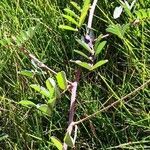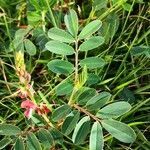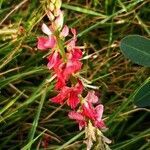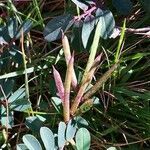Spreading, perennial herb or subshrub, (0.2–) 0.4–0.6 m high; young stems ± flattened and ridged, green or yellowish, strigose with sparse, appressed, equally biramous hairs. Leaves pinnate, with 7–10 leaflets; stipules triangular with scarious margin, 5–7.5 mm long, glabrescent; petiole 1.5–5 mm long; rachis furrowed; multicellular hairs absent; stipellae absent or inconspicuous; leaflets alternate, obovate to elliptic, 5–16 mm long, 2.5–7 mm wide, upper surface glabrous, lower surface with sparse to moderately dense, appressed hairs, apex obtuse and mucronate. Inflorescences 120–150 mm long, longer than leaves; peduncle 10–20 (–25) mm long; bracts ovate to triangular, with scarious margin, 1.2–2.5 mm long; pedicel 0.3–0.7 mm long; flowers pink to red. Calyx 2.5–4 mm long; lobes subequal, longer than the length of the tube, covered with moderately dense, white, appressed hairs. Standard obovate, 3.8–4.9 mm long, 2.5–3.7 mm wide; apex obtuse. Wings oblong to spathulate, 3.7–4.5 mm long, 0.5–1.1 mm wide. Keel 3.9–4.4 mm long, 1–1.3 mm deep; lateral pockets 0.3–0.5 mm long; apex rounded. Staminal tube 3.5–4 mm long, colourless. Ovary moderately to densely hairy. Pods descending, terete to slightly tetragonal, 22–27 mm long, 2.2–2.5 mm wide, dark brown, strigose, glabrescent; apex shortly beaked; endocarp not spotted; seeds cuboid, 7–10 per fruit.
Perennial herb with trailing stems to 1.2 m long. Stems prostrate, flattened or angular, sparsely appressed strigose to glabrescent, arising from a woody rootstock. Stipules 6-14 mm long, lanceolate-acuminate, broadly scarious at base, midrib mostly prominent, continuing as setaceous tip. Leaves pinnately (7)9-11(13)-foliolate; leaf axis 20-46 mm long, including petiole of 1-3 mm, stipels usually present; terminal leaflet 12-37 x (2.5)3-9(14) mm, oblanceolate to oblong, glabrous above or rarely with isolated hairs, ± densely appressed strigose beneath. Raceme up to 23 cm long, including peduncle of 8-25 mm; bracts 1-3 mm long, lanceolate; pedicels 0.5-1 mm long. Calyx 2-3(4) mm long, sparsely strigose; lobes narrowly lanceolate-subulate, 2-3 times as long as tube. Stamens (3.5)4-5 mm long, mostly exceeding calyx by c. 1 mm. Pod 16-25 x 1-1.8 mm, sharply deflexed, overlapping in very dense infructescences, ±4-angled or rarely constricted at intervals when young, mostly incurved distally towards rachis or ± straight, sparsely strigose, drying dark brown. Seeds 5-8, 1.2-1.6 x 0.8-1 mm, ± oblong, greenish-brown.
Perennial trailing herb, up to 1.2 m long; rootstock woody, stems flattened or angular, sparsely appressed strigose. Stipules 6-14 mm long, lanceolate-acuminate, scarious at base, midrib prominent. Leaves pinnately (7)9-11(13)-foliolate, leaflets alternate; petioles 1-3 mm long. Terminal leaflet (7)10-37 x (2.5)3.0-9.0(14.0) mm, narrowly oblanceolate to oblong-elliptic, glabrous above, ± densely appressed strigose beneath. Inflorescences of 100-230 mm long, densely many-flowered racemes; peduncle 8-25 mm long; pedicels 0.5-1.0 mm long. Flowers 5-6 mm long, red. Calyx 2-3(4) mm long, sparsely strigose; lobes narrowly lanceolate-subulate, 2-3x tube length; standard with dorsal surface densely strigillose. Stamens (3.5)4.0-5.0 mm long. Flowering time Dec.-July. Pod 16-25 x 1.0-1.8 mm, overlapping in dense infructescences.






